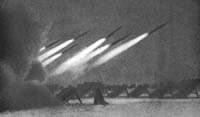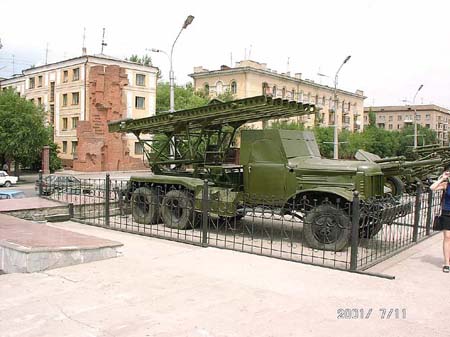
The origins of GDL and GIRD.
The History of Soviet Rocket Development
History of GDL (Gas Dynamics Laboratory) Leningrad
Created in 1921 to develop the ideas of Nikolay Tikhomorov for using slow burning solid explosive substances for self-propelled mines for air and water.
After moving to Leningrad from its initial base in Moscow GDL focused its activities on the production of smokeless solid propellant projectiles.
Vladimir Artemyev collaborated with Tikhomirov on many joint scientific publications and together they developed the first solid propergol rocket engines.
Directors of GDL :
1921 Nikolay Tikhomorov
1930 Boris Petropavlovskiy.
1933 Ivan Kleymenov.
A young V. Glushko , aged 21, started at GDL in 1929 after graduating from Leningrad University. Working on electric-thermal thruster, liquid propergol and high boiling point liquid propellant propulsion.
1930 Range testing of the RS-82 and RS-132 solid propellant artillary rockets for aircraft
1932 RS-82 rockets test fired from Illyushin I-4 aircraft.
1932 Vyacheslav Dudakov developed solid propellant rockets for assisting take-off of aircraft TB-1 and TB-3 heavy bomber.
Kleymenov before being appointed as head of GDL had voluntered for the Red Army and subsequently studied mathematics and physics at Moscow University before completing his studies at the Zhukovsky Air foece Academy.
His new responsibilities were to develop solid propellant rockets for applications to aircraft and ground based multi-barrel artillary rocket launchers.
Kleymenov, Artemyev and Langemak were all heavily biased to towards developing solid propergol rockets.
Tikhomorov, Kleymenov and Langemak had all followed similar career paths Red Army volunteers etc.
By 1933 GDL had an estimated 200 staff that were directly responsible to the Millitary Research Committee.
History of GIRD (Gruppa Izucheniya Reaktivhogo Dvizheniya)
Moscow rocket propulsion group
Directors of GIRD :
1931 Frederikh Tsander.(44)(1887-1933)
1932 S. P. Korolev (25)
Frederikh Tsander scientist, inventor and romantic visionary of interplanetary space travel.
In 1914 Tsander graduated with honours from the Riga Polytechnic Institute leaving in 1915 to work for The Motor Aircraft Works at the TsAGI (Central Aerohydrodynamics Instutute) in Moscow. In 1928 he would later meet Korolev who at that time was lead engineer responsible for design and development of an auto-pilot for Andre Tupolev’s TB-3 heavy bomber.
Tsander had began work on jet propulsion theory in 1908. Inspired by the work of Tsiolkovski. Writing articles on space flight and rocket propulsion.
Collaborating with Tsiolkovski on several projects he was one of the first to indentify how sunlight might be used to power interplanetary spacecraft at high velocity through space.
In 1929 he started work on his first liquid propergol engine carrying out extensive trials and experiments during the summmer of 1930. After finishing work at TsAGI he spent all his spare time evenings, weekends and hoildays absorbed in the quest to develop a reliable rocket engine. Now aided by Korolev.
Although rudimentary in design this work lead to the creation of the OR-1 rocket engine. A very simple design concept based on the principle of a modified blow lamp. It could be run on different liquid propergols so that an assesment of the different propergols could be made.
Financed solely by enthusiasm ; the experience gained by running the OR-1 engine over a development series of over 50 test firings contributed to the next design phase OR-2 engine using liquid oxygen and petrol as propergols. OR-2 incorporated several modifications to prevent burn through, a combustion chamber cooled by circulating liquid oxygen ( regeneratively cooled) and a water cooled expansion nozzle. Developing 489 N (Kgf) thrust.
1 lbf = 4.4482N.
When another colleague at TsAGI, Yuriy Pobedonstsev joined Tsander and Korolev in 1931.The ball was rolling…
Financed by a collection made by his TsAGI workmates ,equivalent to two months salary, Tsander started out on his conquest of space.
GIRD officially started in the Autumn of 1931.
‘Onwards to Mars’ was his inspired phrase at the start of each new working day at the GIRD.
In 1924 he wrote ‘Flights to other planets’.
Responsibilities at the GIRD covered a wide range of rocket development projects. :
S. P. Korolev Was responsible for stratopheric aircraft with liquid propellant generated rocket propulsion.
Yuriy Pobedonstsev had responsibility for the design and development of RAM jets.
Mikhail Tikonravov First hybrid propellant, oxygen-alcohol and oxygen-kerosene rocket engines.
Vladimir Vetchinkin
Yevgeniy Shchetinkov
In 1932 Andrey Kostikov joined the GIRD working in the Tikonravov and Pobedonstsev project groups.
In 1932 GIRD had 60 staff funded jointly by the Osoaviakhim organisation and RKKA Directorate of Miltary Inventions.
During 1932 Tsander was suffering from overwork and failing health. Korolev managed to organise a pass for Tsander to take a break to recover at a special clinic at Kislovodsk in the Crimea. Whilst staying in Kislovodsk Tsander contracted a secondary illness from which he never recovered. His sudden loss in March 1933 ment that
Korolev had now to assume the role of inspirational leader.
As a mark of respect in 1957 Korolev returned to Kislovodsk to identify the unmarked grave of Tsander. On what would have been Tsanders seventieth birthday.
The Creation of RNII 21st September 1933
RNII was created by merging GDL and GIRD into a single research and design unit based in Moscow.
.
Kleymenov was made head of RNII and Korolev was apponited as his assistant.
Kleymenov, Artemyev and Langemak were all heavily biased to developing solid propergol rockets and came from a ballistic Red Army background that contrasted with that of the GIRD members
When it was clear that the priorities of Kleymenov, Artemyev and Langemak were to continue as at GDL with priority given to solid propergol rocket projects. It was inevitable that there would be a conflict along the lines of the former GDL and GIRD groups.
Tikonravov was responsible for the development of liquid oxygen and alcohol liquid propergol rocket engines and structures.
Pobedonstsev initial responsibilty was the design and development of RAM jets and then solid propellant rockets. RNII designed and developed the famous ‘Katyushas’ artillary rockets.
Korolev’s primary responsibility was the design and construction of a rocket powered glider and winged missiles.
Within a few months of the creation of RNII by January 1934 Korolev had been demoted and replaced by Langemak. This also coincided with the arrival of GDL staff from Leningrad.
The earlier GDL trio of Kleymenov, Artemyev and Langemak had gained a strategic victory.
The steering science and technical committe that controlled RNII was as follows :
Director : Kleymenov
Chairman :Georgy Langemak
Technical committe members : Glushko, Korolev, Pobedonstsev, Tikonravov and Dudakov
Konstantine Tsiolkovski was made an Honorary member of RNII on 23rd June 1935 several months before he died.aged 78.
Starting from January 1934 all GDL personnel transfered to Moscow.
V.Glushko was joined by D. Shitov, V. Galkovskiy and S. Rovinsky. The team worked on single and double chamber rocket engines using the liquid propergols nitric acid with tertanitromethane and nitric acid/kerosene. Producing 600N thrust.
V. Glushko developed the ORM nitric acid rocket engines between 1934 –1937. Producing the ORM-65 nitricacid/kerosene engine for Korolev’s 212 cruise missile and RP318 rocket powered glider.
Directors of RNII > NII-3 :
Ivan Kleymenov (1932-January 1937)
Boris Slonmer (January 1937-Late 1939)
Andrey Kostikov (Late1939-
After 1937 RNII became NII-3
‘Katyushas’ artillery rockets.
World War 2 Soviet 'Katyushas '
The development of the 'Katyushas' rocket was undertaken at NII-3 by Georgy Erkhovich Langemak who lead a team of three principle engineers
Vladimir Artemiev, Boris Petropavlovskiy and Yuri Pobedonostsev
Without the determination of Colonel Aborenkov. Solid propellant rockets would not have been introduced as a strategic form of rocket artillary. Because of the conservative opinion of Marshall Kulik.
Following Aborenkov insistance NII-3 was given some additional help in developing self propelled multiple launchers for the Katyushas.
In 1939 Gvay, Pavelenko, Galkovskiy and Popov produced a self propelled launcher based on the ZIS-6.
Because of his experience with solid propelled rockets launched from aircraft Aborenkov was absolutely convinced of the importance of developing self- propelled multiple rocket launching platforms for land artillary
In March 1941 NII-3 with the assistance of GAU’s Colonel Aborenkov, carried out several successful range firings.
However Marshall Kulik still wasn’t convinced. With the result that planned demonstrations were continually postponed or delayed.
Finally on the 15th June 1941 a demonstration was made with two BM-13 launchers with twenty four Katyushas each. The sight and sound created by a volley of 48 Katyushas rockets pounding into the target area left everybody in the distiguished company stunned.
Minister of Defence Timishenko bluntly addressed Marshall Kulik for his lack of foresight in developing this project for active service. With Stalin himself signing for the approval of Katyushas rocket and self propelled launcher production just 24 hrs before the declaration of war with Germany.

NII-3 Self-propelled 'Katyushas' launcher on permanent exhibition in Stalingrad
Short video of Katyushas launch during The Great Patriotic War (World War 2) with sound
http://www.youtube.com/watch?v=9m2_s-13d8w
http://www.youtube.com/watch?v=mHLAcv4_WCA&NR
http://www.youtube.com/watch?v=va9Kg8AvP6U&mode=related&search=
The Stalin Purges of 1937-1938 left NII-3 leaderless.
First in January 1937 Ivan Kleymenov and Georgy Langemak where arrested by th NVKD and executed in January 1938.
Then in 1938 first Glushko then Korolev where arrested and sent to NVKD work camps or Gulags.
With the heart of the Soviet rocket team ripped out. The German rocket development programme at Peenemunde now had no competition. Until near the end of World War 2 in 1944 when Churchill informed Stalin of the secret German rocket facility at Peenemunde.
Stalin repatriated his imprisoned rocket experts so that they could travel to Germany and discover what the Germanies rocket engineers had been working on since1935.
References
Borid Chertok Rockets and People 1
James Harford Korolev
his site was created on the 15th April 2003
©John Gwynn and sons2003
You're welcome to reproduce any material on this site for educational or other non commercial purposes
as long as you give us proper credit (by referring to "The Water-Rocket Explorer" http://waterocket.explorer.free.fr".